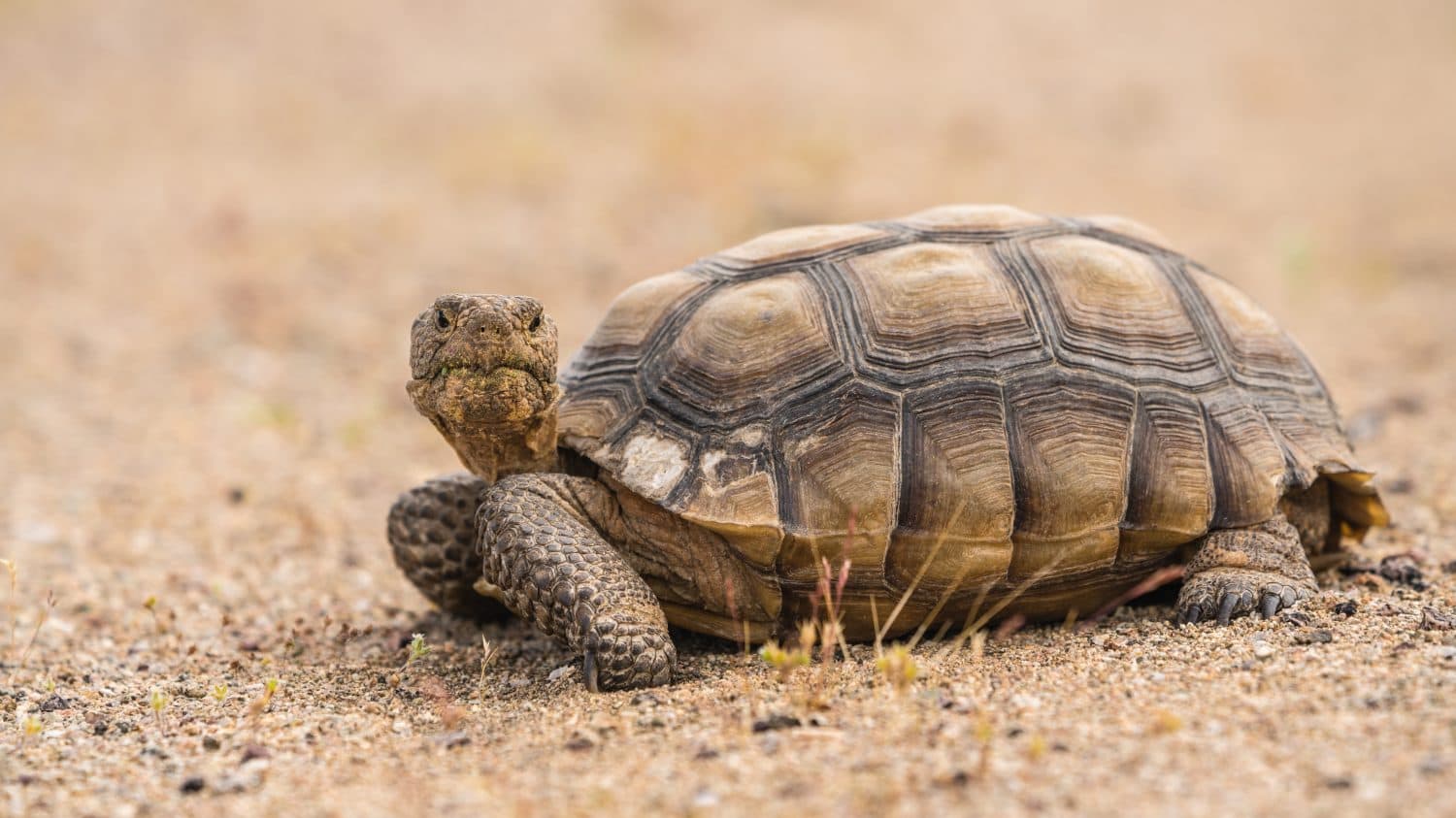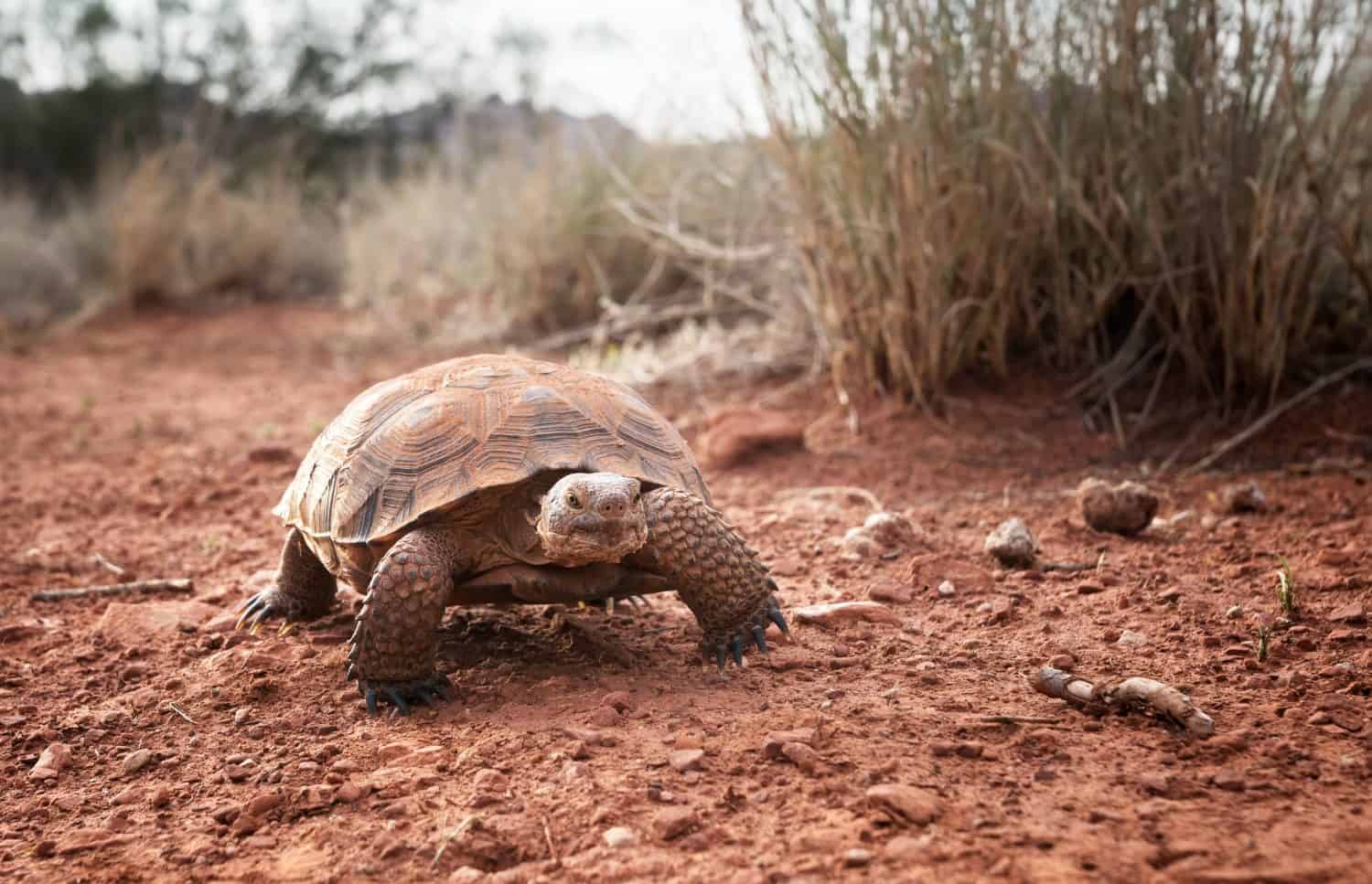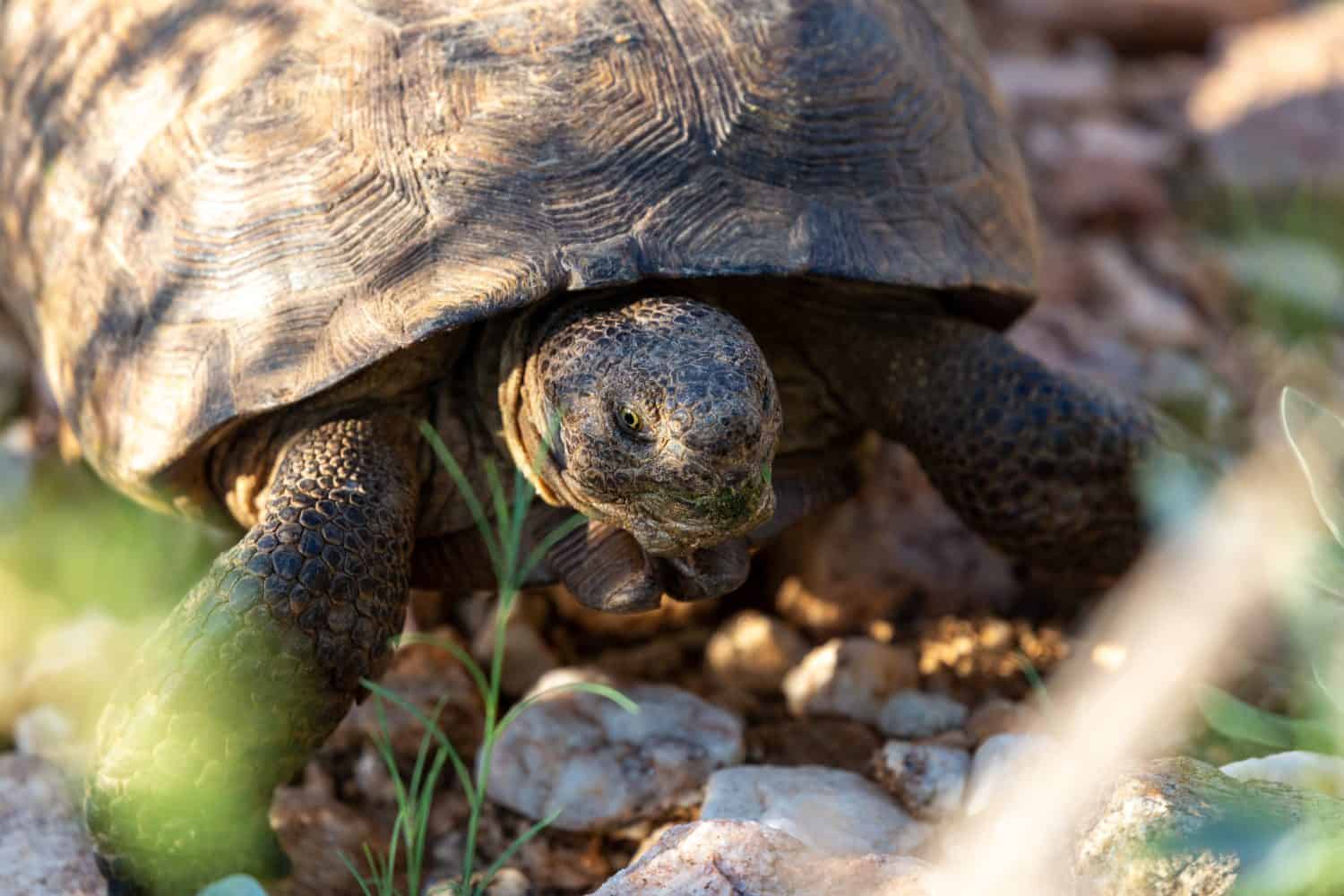The desert tortoise is one of the many animals hikers encounter along Mojave and Sonoran Desert trails. But you’re lucky if you come across one because they spend most of their lives underground, coming up to eat, mate, and bask in the sizzling sun. So what do you do if the rare opportunity to gaze at this ancient reptile in the wild presents itself? Discover how hikers work around the threatened desert tortoise and what they do when they spot one along a trail.
Desert Tortoise Types

The Sonoran Desert tortoise spends nearly 95% of its life underground.
©Sean R. Stubben/Shutterstock.com
There are three species of desert tortoise which are native to the Mojave, Colorado, and Sonoran Deserts of the United States and Mexico.
Agassiz’s Desert Tortoise
One species is Agassiz‘s desert tortoise (Gopherus agassizii) also known as the Mojave desert tortoise. Hikers will see this species in the desert scrub and desert valleys in the Mojave and Colorado Deserts. Unfortunately, their populations have significantly declined in recent years.
Morafka’s Desert Tortoise
The Morafka’s desert tortoise (Gopherus morafkai) is most commonly called the Sonoran desert tortoise. This species lives in the desert scrub on rocky hillsides in the Sonoran Desert in Arizona and Mexico. They spend nearly 95% of their lives underground to avoid the harsh desert. However, they are most active above ground from mid-March to October.
Goode’s Thornscrub Tortoise
The last species is the Goode’s thornscrub tortoise (Gopherus evgoodei) also called the Sinaloan thornscrub tortoise. You can find them in the hills and low mountains surrounded by boulders and rock outcroppings in Sinaloa and Sonora, Mexico. Little is known about the Goode’s thornscrub tortoise biology and conservation status. Hikers will only come across this species in Northern Mexico.
Animals That Rely on the Desert Tortoise for Survival
Many desert species benefit from the presence of the threatened desert tortoises and their burrows. Such species include the Gila monster, burrowing owls, roadrunners, and collared peccaries.
Ravens are a top predator for desert tortoise babies, causing significant declines in their population. Baby tortoises have a high mortality rate due to ravens and other desert predators. On the other hand, coyotes, bobcats, foxes, and eagles prey on adult tortoises. However, adult tortoises are rarely killed by predators.
When to Spot a Desert Tortoise

Spring is the active season for the threatened desert tortoise.
©clayton harrison/Shutterstock.com
The desert tortoise is a keystone species, meaning they are essential for the success of the surrounding ecosystem. Other animals and plant life depend on their presence for survival. Without them, the desert ecosystem would be completely different or cease to exist altogether.
Spring is the active season for the threatened desert tortoise. The specific dates depend on the weather, but they prefer the spring and summer climates. Every year, they are active from March to June, then again from September to October. The active season is when hikers must work around the threatened desert tortoise.
The best time to spot desert tortoises is in early spring from mid-morning to mid-afternoon because they are the warmest parts of the day. As the days get warmer, the tortoises will emerge from their burrows earlier in the day and return to them earlier at night. For example, by May, they are often out and about starting at 6 AM and settling in for sleep by 9 PM.
Outside of the active months, they hibernate within their burrows. In fact, they hibernate up to nine months yearly, starting when the ground temperatures drop to 60 degrees Fahrenheit.
You can occasionally spot them on early summer mornings following thunderstorms. Summer storms enrich their food supply, allowing them to feast on the greenery and replenish their water reserve before returning to their burrow to rest.
Sometimes, they briefly emerge from their slumbers on warm, sunny days in late fall or winter. On days like this, you can find them just at the mouth of their burrows.
How Hikers Work Around the Threatened Desert Tortoise

Typically, hikers work around the threatened desert tortoise by leaving them alone.
©IrinaK/Shutterstock.com
Hikers exploring the Mojave Desert and the Sonora Desert are the most likely to cross a desert tortoise. Although these reptiles spend most of their lives in underground burrows or camouflaged as rocks, they cross the desert for food, water, and mating.
Many popular trails take travelers on foot or bike right through mostly untouched parts of the desert where they live. As a result, it’s possible to find yourself beside one, basking in the sun.
So, how do hikers work around the threatened desert tortoise? The best thing to do is leave them alone.
Taking a quick picture is fine, but stay a respectable distance away. After a few moments, they will amble off to get away from you and continue their mission. Make sure to move slowly and stay quiet to prevent stressing them out. Otherwise, they will hide in their shell until you leave.
On most trails, that’s all the interaction you’ll get if you manage to come across the elusive reptile. But in the rare case you see a desert tortoise in the middle of a busy bike trail or in a vehicle’s path, you may need to intervene.
Assess the situation and the reptile’s size before handling. If the desert tortoise is in danger of being stepped on or run over, moving them off the trail is acceptable. However, leave them alone if they aren’t in imminent danger or move out of the way without help.
What Not to Do If You See a Threatened Desert Tortoise While Hiking

Handling a desert tortoise is illegal unless it’s in danger.
©Charles T. Peden/Shutterstock.com
Now you know how hikers work around the threatened desert tortoise. But what should they not do?
If you see a tortoise while hiking, don’t pick it up. When frightened, the species voids its bladder. An empty bladder can mean death for a desert tortoise. Their bladder is a water reserve to prevent dehydration in the hot desert. In fact, they can store water in their bladder for nearly a year. Without water in their body and a lack of a water source, the tortoise can die.
Handling the threatened desert tortoise is illegal under the Endangered Species Act. However, there are rare instances where properly handling them is necessary. For example, if you are on a road and a tortoise is in imminent danger of being struck by a vehicle, safely moving it is acceptable.
Steps to Properly Handle a Tortoise

Always keep a barrier between your hands and a tortoise’s shell to prevent the spread of disease.
©yhelfman/ via Getty Images
Don’t assume the tortoise needs your help because you see them standing in the trail. Tortoises are slow and often need a few minutes to get moving. As a result, you should keep your distance and wait so it doesn’t feel threatened. Warn the hikers coming up the trail behind you.
It’s unlikely you will need to remove a tortoise from the path, but it’s important to be prepared. Here’s how hikers work around the threatened desert tortoise when they need to intervene:
- Find something to use as a barrier between your hands and the shell. A barrier can be a pair of gloves, a shirt, or a newspaper. Using a barrier helps prevent the spread of an upper respiratory disease that tortoises can spread to one another.
- Firmly pick up the desert tortoise with one hand on either side of their shell.
- Hold the tortoise so it’s facing away from you with your arms out in front of you.
- Hold it several inches above the ground and move slowly. Be mindful because the tortoise will try to break free of your grasp.
- Stay calm and quiet so it doesn’t get scared.
- Don’t take them far from where you found them. Gently place them down in the direction they were heading about 50-100 feet from the road in the shade. If you place them in the opposite direction, they will meander back into the road.
Once you have moved the threatened desert tortoise out of harm’s way, wait a few minutes to guarantee they don’t wander back into the trail. Then, continue down the trail knowing you are helping conservation efforts by saving a life.
The photo featured at the top of this post is © Gchapel/Shutterstock.com
Thank you for reading! Have some feedback for us? Contact the AZ Animals editorial team.






